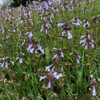SALVIA LYRATA - LYRE-LEAVED SAGE
The plants arrived strong and healthy and adopted their new home as though they've always been here/
Highly adaptable and freely seeding native perennial. This is fairly small/narrow plant that grows from flat basal rosette of leaves with showy flowers.
Great for naturalization or groundcovering substitute for lawn.
Blooming Time: Flower in May/June
Size: Usually grows to 1.5' in height (to 2' in rich soil)
USDA Zones: Hardy in zones 5 to 9.
Culture: Full sun, half shade, light shade, adaptable to all soil types, including rich, acidic, calcerous, sandy, gritty or clay.
Moisture Needs: Medium-dry, medium to medium-wet soils. Tolerates droughts, seasonal flooding and even consistent mowing!
Origin: Native to south, southeast and Midwest, see the BONAP distribution map.
Black Walnut Tolerant: yes
Deer/Rabbit Resistant: no, deer may browse on the plants, but this is a prolific seeding plant, so it will stay around.
Attracts Butterflies or Pollinators: yes/yes
Attracts Hummingbirds: yes
Pot Size: square 3.5" x 5" deep pot
Plant Combinations: Best used in meadows, wildlife gardens, prairie, pollinator or hummingbird gardens. Rosettes often form dense groundcovering carpet, so can be used as substitute for lawn, good for slopes or difficult to mow areas and patches.This sage can't compete to tall plants, so it will fill areas around them.
Picture copyright : US Perennials nursery
Highly adaptable and freely seeding native perennial. This is fairly small/narrow plant that grows from flat basal rosette of leaves with showy flowers.
Great for naturalization or groundcovering substitute for lawn.
Blooming Time: Flower in May/June
Size: Usually grows to 1.5' in height (to 2' in rich soil)
USDA Zones: Hardy in zones 5 to 9.
Culture: Full sun, half shade, light shade, adaptable to all soil types, including rich, acidic, calcerous, sandy, gritty or clay.
Moisture Needs: Medium-dry, medium to medium-wet soils. Tolerates droughts, seasonal flooding and even consistent mowing!
Origin: Native to south, southeast and Midwest, see the BONAP distribution map.
Black Walnut Tolerant: yes
Deer/Rabbit Resistant: no, deer may browse on the plants, but this is a prolific seeding plant, so it will stay around.
Attracts Butterflies or Pollinators: yes/yes
Attracts Hummingbirds: yes
Pot Size: square 3.5" x 5" deep pot
Plant Combinations: Best used in meadows, wildlife gardens, prairie, pollinator or hummingbird gardens. Rosettes often form dense groundcovering carpet, so can be used as substitute for lawn, good for slopes or difficult to mow areas and patches.This sage can't compete to tall plants, so it will fill areas around them.
Picture copyright : US Perennials nursery
The plants arrived strong and healthy and adopted their new home as though they've always been here/
